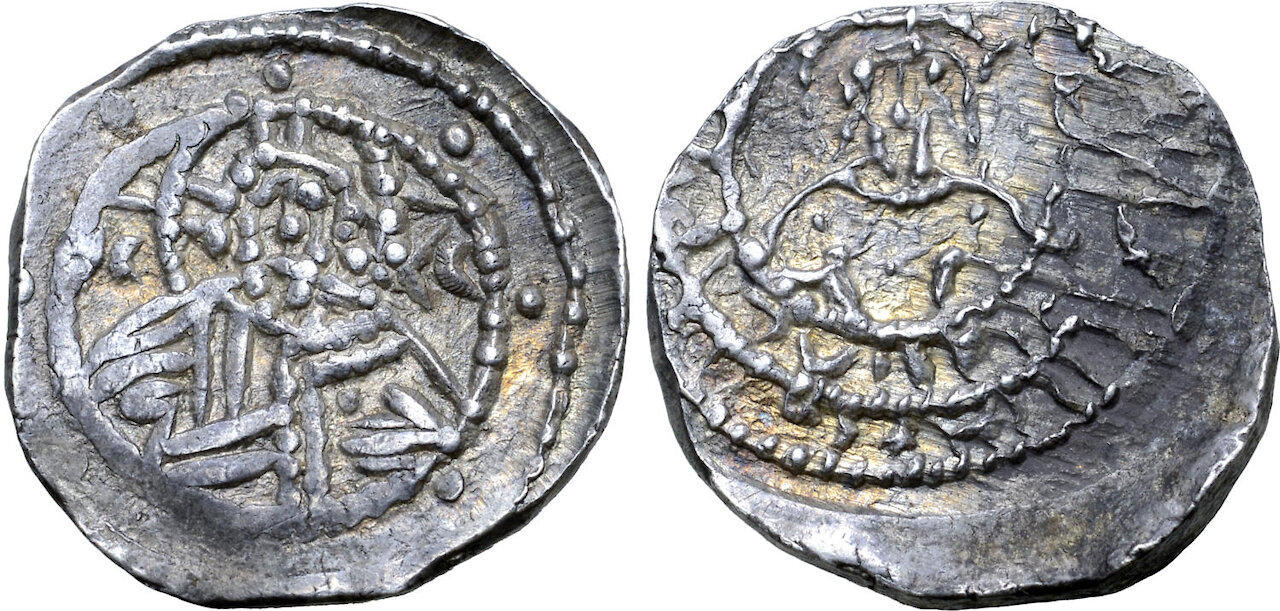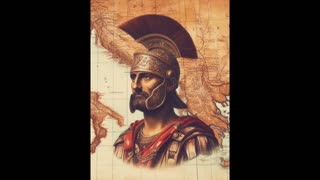Premium Only Content

ΝΟΥ͂ΜΜΟΣ: KWNCTANTINOC ΔΕCΠΟΤΗC Ο ΠΑΛΕΟΛΟΓ - ΘV ΧΑΡΙΤΗ ΒΑCΙΛΕΩC ΡΟΜΕΟΝ
ΝΟΥ͂ΜΜΟΣ: KWNCTANTINOC ΔΕCΠΟΤΗC Ο ΠΑΛΕΟΛΟΓ - ΘV ΧΑΡΙΤΗ ΒΑCΙΛΕΩC ΡΟΜΕΟΝ
http://zazzle.com/ProVaticanus
Constantine XI Palaeologus AR Stavraton. Constantinople, Siege of Constantinople, AD 1453. Bust of Christ facing, wearing nimbus cruciger and holding book of Gospels, IC and B to left and right / KWNCTANTINOC ΔΕCΠΟΤΗC Ο ΠΑΛΕΟΛΟΓ in the outer circle, ΘV ΧΑΡΙΤΗ ΒΑCΙΛΕΩC ΡΟΜΕΟΝ in the inner circle, crowned bust of Constantine facing, wearing maniakon. Bendall, Revue Numismatique 1991, 'The Coinage of Constantine XI', pp. 135-142, pl. XV, 93 (this coin). 6.78g, 23mm, 12h.
Good Extremely Fine; attractive cabinet tone. Extremely Rare and of great historical importance.
This coin published in S. Bendall, The Coinage of Constantine XI, in Revue Numismatique (Paris, 1991);
From the Long Valley River Collection;
Privately purchased from Harlan J. Berk Ltd., 16 July 1990;
From the Constantine XI Hoard, buried in 1453 just before or after the fall of Constantinople, reportedly unearthed in or near Istanbul, c. 1989.
The reign of Constantine XI is primarily remembered for marking the end of the so-called 'Byzantine' Empire, the remainder of the Eastern Roman Empire that had stood for a thousand years after the fall of Rome and the West.
Constantine XI succeeded his brother John VIII Palaiologos on 6 January 1449, and had reigned for only two years when the Ottoman Sultan Murad II died, being followed by his zealous nineteen year old son Mehmed II, who was obsessed with the conquest of Constantinople. A diplomatic miscalculation on the part of Constantine was seized upon by Mehmed as a convenient casus belli, and preparations for war commenced. In the winter of 1451/2 Mehmed cut off Constantinople from the Black sea by establishing a fortification on the European side of the Bosporus which together with the existing fort on the Asian side, gave the Turks complete control of the strait. Specifically, it prevented help from Genoese colonies on the Black Sea coast from reaching Constantinople. Realising that a siege was imminent, Constantine prepared his defence of the city.
Despite appealing to the Pope and Western princes for aid in the defence of the city, little help came. France and England were weakened by the Hundred Years War, Spain was in the final stages of the Reconquista, the German states were wracked by infighting and Hungary and Poland had suffered a crushing defeat at Varna which they had not recovered from. In the end only a few soldiers from the northern Italian city states arrived, together with some adventurers and independent companies. Any hope of help from Constantine's brothers in Morea was dashed by an Ottoman invasion of the peninsula intended to pin down their troops.
In the winter of 1452 Mehmed arrived with his army at Constantinople, and the siege of the city began. Greatly depopulated over the years, Constantinople was now a city of just 50,000 inhabitants, with an army of only 7,000 to defend them. Arrayed against Constantine was a force at least ten times larger than his, with state of the art artillery provided by the gunsmith Orban. After a siege of fifty-three days and determined fighting, the city fell. When all hope had faded, according to Michael Critobulus (writing later in Mehmed's service) Constantine tore off his imperial regalia so as to let nothing distinguish him from any other soldier and led his remaining men in a last charge, perishing in the fighting.
Struck during the siege of Constantinople, the present coin is illustrative of how far the empire had fallen. Its fabric is crude, struck on recycled silver from church altar vessels (attested to by contemporary and eyewitness reports, including those of Leonard, Archbishop of Chios and Nicolo Barbaro) in order to pay the soldiers, ditch diggers and builders engaged in the defence of the city, and the quality of the artistry no better than the worst barbaric imitative issues of the migration period, yet the historical importance of these extremely rare coins cannot be overstated. 29 May 1453 is often cited as end of the late Middle Ages of the post-classical era, and the start of the early-modern period. The siege coinage of Constantine XI can thus rightly considered to be the last 'ancient' coins.
#ConstantineXI #RomanEmpire #SPQR
Gratias ago tibi Deo per instrumenta de Jove Mauro Cámara.
-
 6:09
6:09
ProVaticanus
1 month agoDVX DALMATIÆ
231 -
![🔴[LIVE TRADING] Markets Finally Push Higher!!! || The MK Show](https://1a-1791.com/video/fww1/05/s8/1/1/C/3/E/1C3Ey.0kob-small-The-MK-Show-Apr.-25th.jpg) LIVE
LIVE
Matt Kohrs
8 hours ago🔴[LIVE TRADING] Markets Finally Push Higher!!! || The MK Show
25,268 watching -
 UPCOMING
UPCOMING
Badlands Media
6 hours agoBadlands Daily: April 25, 2025
4.03K -
 LIVE
LIVE
Wendy Bell Radio
5 hours agoSmells Like Dem Panic
9,385 watching -
 LIVE
LIVE
LFA TV
12 hours agoALL DAY LIVE STREAM - 4/25/25
12,196 watching -
 1:31:32
1:31:32
BEK TV
9 hours agoThe Truth About Autism, Vaccines, and Parasites They Don’t Want You to Know - Dr. Jason Dean
3.04K -
 25:12
25:12
JasminLaine
18 hours agoMark Carney Gets GRILLED By Reporter—Lies Finally Get Fact-Checked… PUBLICLY
18K34 -
 11:46
11:46
Tactical Considerations
16 hours ago $4.80 earnedKimber CDS9 The Micro 1911 That Seems To Have It All
25.7K4 -
 15:48
15:48
IsaacButterfield
1 day ago $3.45 earnedWoke Lunatic ATTACKS My 2 Year Old Son!!
31.2K30 -
 55:00
55:00
The Hannah Faulkner Show
22 hours ago $2.55 earnedKLAUS SCHWAB RESIGNS & A NEW POPE with Mike Crispi | The Hannah Faulkner Show
30.1K9